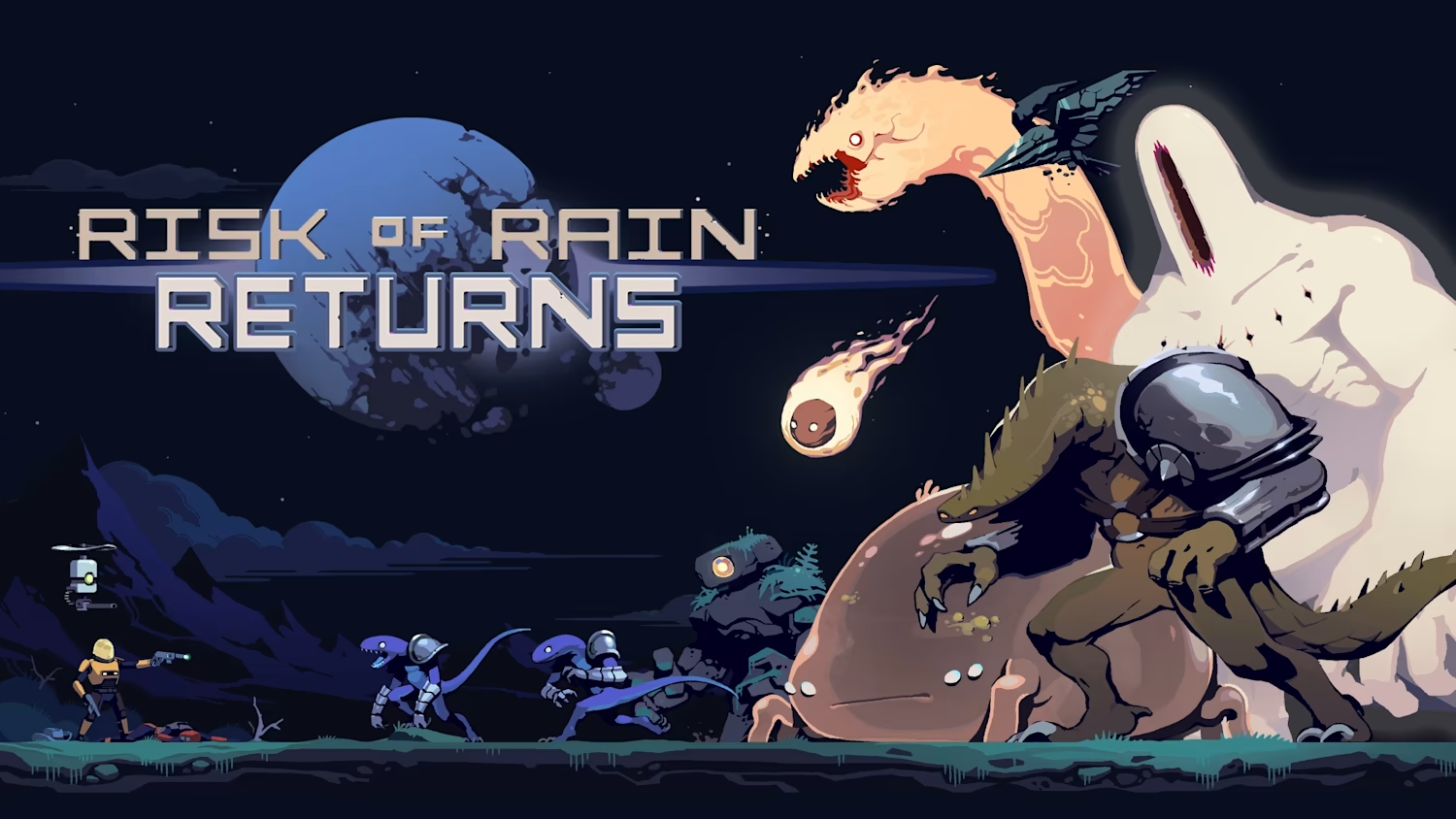Risk of Rain (RoR) is a 2013 2d rouge-like shooter/platformer released in 2013, developed by Hopoo Games, at the time Duncan Drummond and Paul Morse, and published by Gearbox Publishing, to an audience that helped fund it via Kickstarter. It did well, well enough in fact that they released a sequel in 2019 called Risk of Rain 2 (RoR2), taking the original and putting it into 3d, and eventually, on RoR’s 10th anniversary, a remastered version called Risk of Rain Returns (RoRR). I will be focusing on this remaster, as well as the original, to continue my developing my understanding of remakes and remasters as pieces of art. I chose these in particular as RoR is one of the first games I really got into and RoRR was something I was extremely excited for and have enjoyed a lot, so what better place to start than something I have strong feelings on so I can try to dismantle them.
To begin, it makes sense to take a closer look at both games and identify what has been changed, added, and updated in the remaster. This shows how Risk of Rain has changed over time and how someone like me experiences this. At the end we’ll look at what RoRR represents with its existence, especially as an evolution of the original dev’s and their team at Hopoo Games’ skills.
Characters and Abilities
Risk of Rain starts you off crash landing in an escape pod in the first level as one of the 12 characters you pick from the menu. The base movement is consistent across all characters that you can play as with variation between them coming from their four abilities which range from attacks for fighting enemies to utilities that increase survivability and movement, and sometimes a mix of both. However, in Risk of Rain Returns, each character now has two different options for each ability which are chosen from the main menu. With this, each character has variation in their base abilities allowing many different unique playstyles within the unique and varied playstyles of all the characters. On top of this, there are also three new characters introduced with the artificer coming from RoR2 with the other two being brand new.



The three new characters in order from left to right: the pilot, the artificer, and the drifter
These new characters and being able to switch abilities add so much to RoRR compared to the original. For players of RoR like myself, new characters and abilities breathe fresh life into what we already loved with new ways to experience it. And for all players alike, if there are characters you don’t enjoy as much, there is now a bigger pool to choose from and you can change the abilities these characters have to suit you better instead of ignoring them outright. This change makes the game even better by getting players to engage with it more, even in cases that RoR would have failed to encourage trying different characters beyond a cursory glance. I certainly felt this way. In RoR I never played as the mercenary, it just felt off and I didn’t enjoy the melee nature of it. Come RoRR, the mercenary is one of my favourite characters now that I have switched some abilities to a parry and the skyward assault.
The Teleporter Event
Bosses in RoR spawn when you activate the teleporter that takes you to the next level. Rather than letting you through straight away a boss spawns, the spawn-rate of regular enemies increases, and a 120 second timer counts down until you can go on. This acts as a three-stage barrier to requiring the timer to reach its end, the boss to be dead, and all regular enemies that spawned to be killed. This is a great challenge as killing the boss is already hard and by then requiring you to survive the increased spawn rate of regular enemies and then kill them all, it becomes very difficult.
However, whilst bosses are much more powerful than any other enemy and are much larger in size to show this as well as just being some of the coolest enemies in the game, this is only a part of the challenge. Unfortunately, whilst requiring you to kill all enemies on the map is a challenge, especially as the horde increases, it becomes tedious at times as you try to hunt down the last enemies that usually end up out of the way. There is an arrow that points you to the nearest enemy, it takes time to go between the last few. There have been many a playthrough I’ve done that has had me spending at least a minute on each level walking in empty space to one enemy out of the way only for another enemy to be on the complete other side of the map. This just takes all the momentum out of the challenge that is the boss fight mere seconds earlier.
RoRR makes a major change to the teleporter event. Not only is the timer reduced to 90 seconds, but now only the boss must be killed to progress to the next level. This both makes it faster to get through due to the reduced timer, but, more importantly, not needing to kill each enemy makes it so much less tedious, something I adore. No longer do you need to circumnavigate the level after you finish off the boss and can instead go straight to the next level. This might be seen as being easier as not needing to kill the horde that spawns during the event removes challenge from the game, we must consider if the challenge of RoR’s teleporter event is worth the tedium that comes with it. Hopoo Games certainly don’t think so after the many years they have worked at improving the Risk of Rain formula, and neither do I.
The Influence of RoR2
As you progress through levels it becomes almost impossible to continue as enemies out-scale your base abilities. To overcome this, you collect items adding different effects to you from healing when killing enemies to all your attacks exploding. These can be collected via chests scattered through each level with money received by killing enemies as well as statues that take money or health for a random chance at an item or give you a short challenge to get one. RoRR adds many more enemies and items to the game to increase the variety in gameplay making each run feel quite different. RoR2 is a big influence on the direction of this game and many of these new additions are adapted from RoR2, for example barrier items. This is a mechanic that provides a type of temporary health that wears off over time.

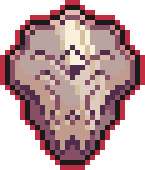
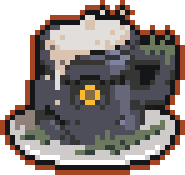
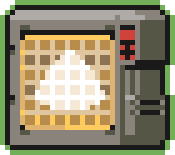
Four barrier items in RoRR with the left two (Topaz Brooch and Aegis) returning from RoR2 and the right two (Golem Essence on the Rocks and Locked Jewel) being brand new
However, with more items this does add more randomness in what items you will get in RoRR, as well as already being a problem in RoR. Again, the solution for this was adapted from RoR2 by introducing category chests. These are slightly more expensive than normal chests but guarantee an item in the specific category of either damage, healing, or utility. The difficulty curve has even been altered based on the RoR2 shrine of the mountain, something that can be interacted with in a level (sometimes multiple times) and makes the boss fight harder but also give more rewards. This allows for a lot of gameplay strategy. Do I try to get ahead of the difficulty curve early making it harder now? Am I in a poor position power-wise requiring me to risk an early death to prevent a later one? It also means that more experienced players can make it harder for themselves whilst keeping the general power curve in line with difficulty for those who decide not to activate the shrines.
Now whilst all these adaptations from RoR2 are cool, only having these might seem like a collision of RoR and RoR2, and not its own thing. I have already mentioned the barrier mechanic and it has evolved from RoR2 with completely new items that do even more with this mechanic in RoRR. There are also other enemies and items that are completely new including a brand new boss. Temporary item vendors have also been added which give you five of one item, but only for a limited time. There are also ways of upgrading and scrapping drones that fight for and heal you, developing the flat bonuses from RoR into a more dynamic system.
All of this together brings so much from RoR2 whilst developing its own ideas that it is perfect for any level of experience in and Risk of Rain game. For those coming from RoR, there is a lot of new stuff to alter the gameplay and provide a new experience. RoR2 players may be trepidatious as they are coming from a 3d game into a 2d one, and with all the recognisable carryovers from RoR2 they will have a better time acclimating to it. Players who kept up with both RoR and RoR2 will see the way Hopoo Games has developed the formula of Risk of Rain taking what they’ve learned and developed a brand new but recognisable experience. This is how I felt every moment I played RoRR. Seeing all the items and enemies from each game and how they were rebalanced made me feel even closer to these games and glad that I’ve been able to experience them all like this.
Difficulty and Accessibility
Difficulty is managed in RoR via two main mechanics. The first is the difficulty selected before starting of drizzle, rainstorm, and monsoon (easy, medium, and hard respectively) which alters the money and health you start with, the cost of buying items, and increased enemy and boss spawn-rate and damage. The second is the local difficulty which is a slowly increasing meter with discrete segments. This meter fills over time as well as in bursts when you get to the next level. As it increases past the discrete segments, the local difficulty increases which makes enemies tougher, deal more damage, spawn faster, and have higher chances of spawning as elites, an even tougher enemy variant with a bonus ability. This keeps a consistent difficulty curve, not just with level progression, but also with time encouraging you to complete levels quickly as there is a limited number of item pickups per level, so you will get out-scaled if you dawdle.

The local difficulty bar with labelled segments
This was kept the same in RoRR as it works very well as a base difficulty curve. However, RoRR also added additional difficulty options. You can now independently adjust the amount of damage you deal, as well as the amount you take to create a more comfortable experience whether that be to make it easier as you learn to play or harder as you want more of a challenge.
There are now also different control schemes that allow different players comfort when playing. There is the classic scheme which uses the controls from RoR, the modern scheme which uses a new keyboard only layout, and the RoR2 scheme which incorporates the mouse to aim. These can all be fully adjusted to blend between each other as well as being able to implement different accessibility features to help with things like mashing buttons and visibility of ui elements, all things not present in RoR allowing for a broader range of players to enjoy it.
You can also toggle if the new additions to the game are turned on, from the new items and enemies to the updated teleporter rules. Together these are called the modern rules and can be turned off as a group or individually. This allows older players to achieve an experience more like what they are used to whilst still retaining the new vision of the game. I’ve found that I keep all the options as default across all these options personally, but it is great to see that there are options that allow everyone to enjoy it whilst keeping the core identity of the game intact.
Modernisation
The biggest, and most wanted update, is the improvement to the multiplayer of the game, something I did not mention earlier. This allows for up to four people to play at the same time. However, RoR was initially made by only Drummond and Morse which made it difficult to manage the multiplayer code requiring the extra steps of port forwarding and IP stuff making it a bit difficult to setup [1]. Now, as their skills have developed, they have a larger team, and Steam has made it much easier to connect people for multiplayer games, the multiplayer setup is leagues better requiring a couple mouse clicks in game through Steam.
During an interview with John Harris at Game Developer, Morse says of some of the major differences the two games have that RoRR has a “matured feature set that a game launching in 2023 is expected to have.” [2] This seems to be referring to the improved multiplayer (which can be confirmed in an interview with Joey Brown at Game Rant [1]), as well as the accessibility options and responsiveness games have today. Modernising a game from the past can be seen negatively as sanding down the edges of a game can result in a worse experience, especially as some expectations can harm what experience a game is going for. However, everything modernised in RoRR was done to allow more people to play it and keeps the core of the game the same. Fixing the multiplayer lets people play the game together properly with no roundabout solution. The increased accessibility and difficulty options allow more people play it comfortably.
Hopoo Games
Whilst RoR was made by Drummond and Morse, over the years Hopoo Games, their company, has grown and employs many people. This allows for upgrades that would otherwise not be feasible with just the two of them. The most noticeable is the new pixel art with the resolution being doubled and each sprite being improved upon giving it a more modern feel. Doubling the resolution quadruples the number of pixels, and therefore the amount of work. Without the team they have developed over the years, it would not have been possible for them to accomplish this.
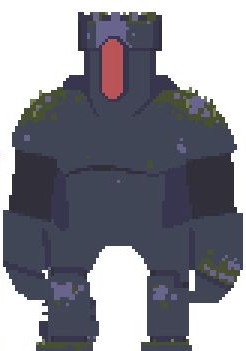
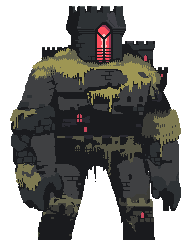
Comparing the old (left) and new (right) colossus boss sprites to show the new level of detail and requirement of their team to accomplish
Another of these upgrades is the introduction of providence trials, something thought up by the team and pitched to Drummond and Morse. These are a collection of 49 bonus missions/minigames that use the core game to create fun little encounters that vastly range in difficulty. Completing these trials rewards you with character abilities, items, and more. You can also get a gold rank in the trials as an additional challenge, and for two other unlockables. This adds heaps of new content to the game and gives something new for older players to do. I found these extremely fun, and since they are relatively short compared to a full run, you can quickly jump into a trial whenever you have a free moment. Some of the most fun I had was in these trials as they are all super unique and mess with the mechanics in cool ways.
Conclusion
Risk of Rain was the product of two people, Duncan Drummond and Paul Morse, whilst they were still university students with some extra help from Matthew Griffin to help finish up some code and Chris Christodoulou to create the soundtrack. This was the first game the two released and it received great reviews and even won them the Best Student Game award at the 2014 Independent Games Festival. After this they made and release Deadbolt and Risk of Rain 2, games that expanded their company Hopoo Games and continued their journey making games. With this time and experience creating games, they would have improved upon their skills as well as developing Hopoo Games into a company with people they can collaborate with.
With these improved skills and a group of people to create with, going back to their start and seeing how they would make RoR now is a wonderful thing. By taking things they learned making their previous games, they brought over ideas they created in RoR2 back into the 2d realm and created more enemies and items to pair with them based on all their new knowledge. With a team of people they can work with, they made the providence trials, an idea that came up independent of the two [1] and shows how the culture at Hopoo Games allows for creativity from everyone.
Risk of Rain Returns, a remaster of Drummond and Morse’s first game and released 10 years later, represents the journey they have gone on, developing their skills and building a space full of people they can make art in. It brought people that started with RoR2 over by updating it to more modern standards. It let people like me that adore RoR re-experience it with a fresh coat of paint and with new things to uncover. A remaster, not for remasters sake, but a continuation of putting themselves out there to the world.
Linking the old to the new.
Showing the path they have gone on to get here.
What better reason is there to create something?
Risk of Rain Returns is a game that really shows what a remaster can be.
[1] – Brown, J. (2023-05-13). Hopoo Games Interview: Devs Talk All Things Risk of Rain Returns. https://gamerant.com/risk-rain-returns-remake-interview/
[2] – Harris J. (2024-04-12). Why Risk of Rain Returns is taking the series back to 2D. https://www.gamedeveloper.com/design/risk-of-rain-interview
2025-04-10 – jam-alade
